ehc BMW X5 2002 E53 Level Control System Manual
[x] Cancel search | Manufacturer: BMW, Model Year: 2002, Model line: X5, Model: BMW X5 2002 E53Pages: 57, PDF Size: 1.89 MB
Page 27 of 57
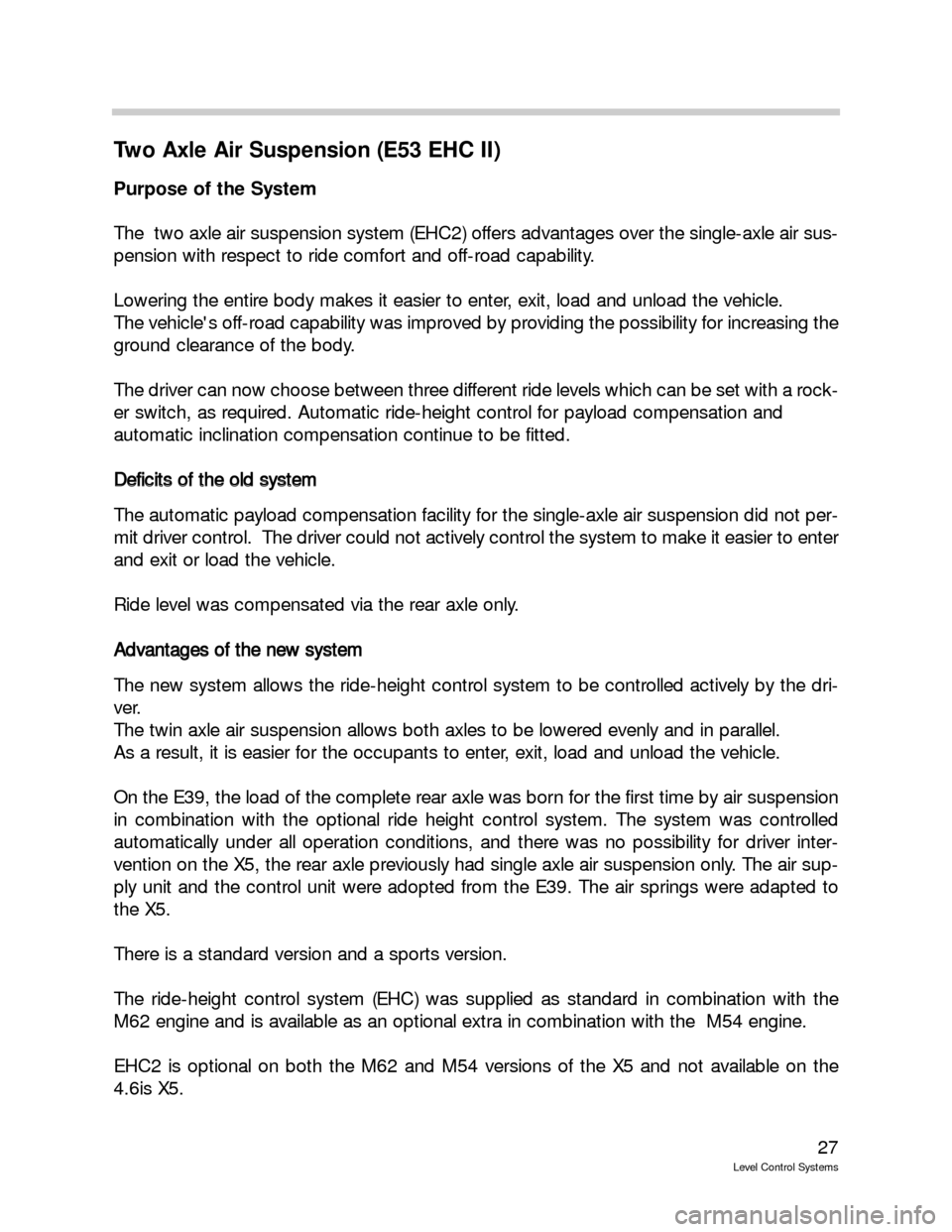
27
Level Control Systems
Two Axle Air Suspension (E53 EHC II)
Purpose of the System
The two axle air suspension system (EHC2) offers advantages over the single-axle air sus-
pension with respect to ride comfort and off-road capability.
Lowering the entire body makes it easier to enter, exit, load and unload the vehicle.
The vehicle's off-road capability was improved by providing the possibility for increasing the
ground clearance of the body.
The driver can now choose between three different ride levels which can be set with a rock-
er switch, as required. Automatic ride-height control for payload compensation and
automatic inclination compensation continue to be fitted.
D De
ef
fi
ic
ci
it
ts
s
o
of
f
t
th
he
e
o
ol
ld
d
s
sy
ys
st
te
em
m
The automatic payload compensation facility for the single-axle air suspension did not per-
mit driver control. The driver could not actively control the system to make it easier to enter
and exit or load the vehicle.
Ride level was compensated via the rear axle only.
A Ad
dv
va
an
nt
ta
ag
ge
es
s
o
of
f
t
th
he
e
n
ne
ew
w
s
sy
ys
st
te
em
m
The new system allows the ride-height control system to be controlled actively by the dri-
ver.
The twin axle air suspension allows both axles to be lowered evenly and in parallel.
As a result, it is easier for the occupants to enter, exit, load and unload the vehicle.
On the E39, the load of the complete rear axle was born for the first time by air suspension
in combination with the optional ride height control system. The system was controlled
automatically under all operation conditions, and there was no possibility for driver inter-
vention on the X5, the rear axle previously had single axle air suspension only. The air sup-
ply unit and the control unit were adopted from the E39. The air springs were adapted to
the X5.
There is a standard version and a sports version.
The ride-height control system (EHC) was supplied as standard in combination with the
M62 engine and is available as an optional extra in combination with the M54 engine.
EHC2 is optional on both the M62 and M54 versions of the X5 and not available on the
4.6is X5.
Page 28 of 57
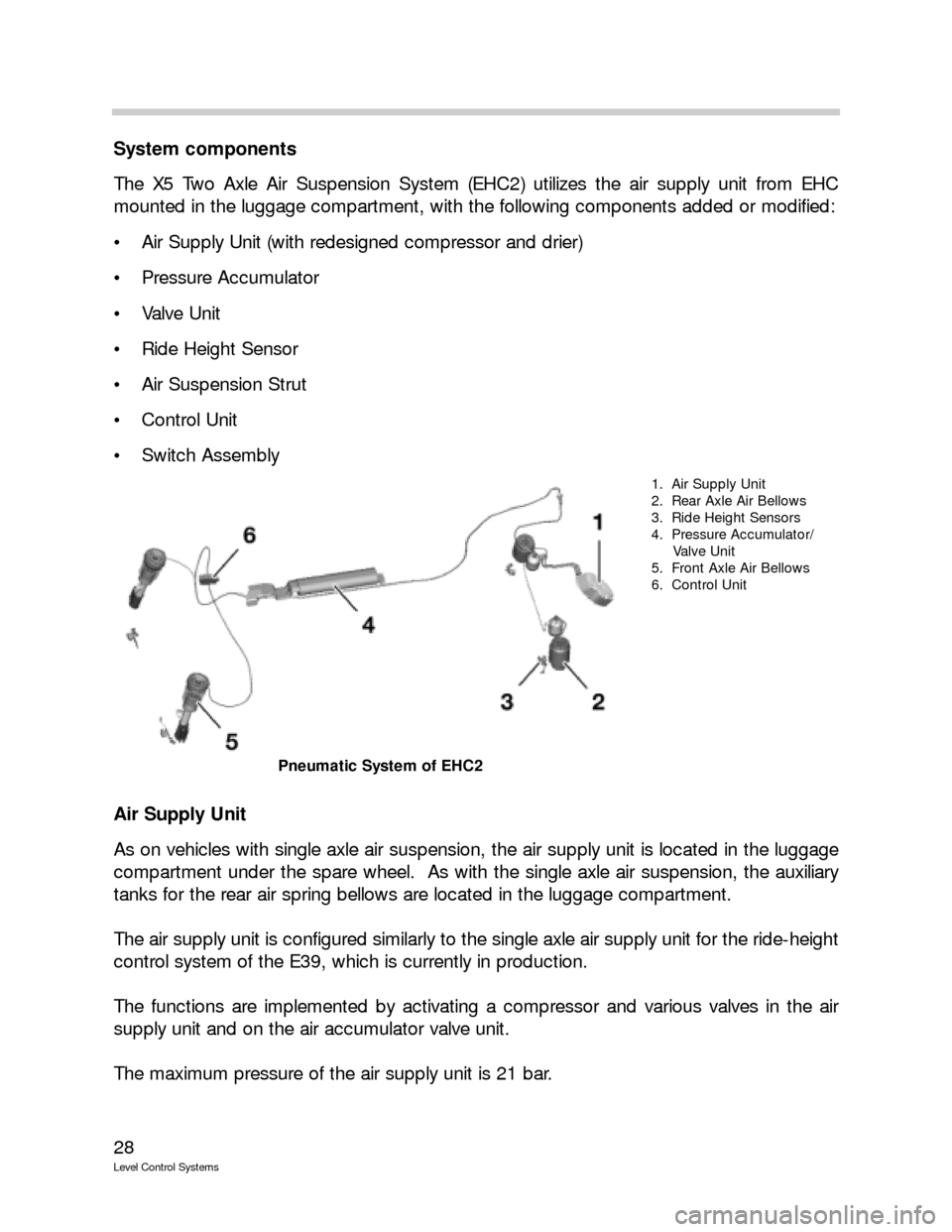
28
Level Control Systems
System components
The X5 Two Axle Air Suspension System (EHC2) utilizes the air supply unit from EHC
mounted in the luggage compartment, with the following components added or modified:
Air Supply Unit (with redesigned compressor and drier)
Pressure Accumulator
Valve Unit
Ride Height Sensor
Air Suspension Strut
Control Unit
Switch Assembly
Air Supply Unit
As on vehicles with single axle air suspension, the air supply unit is located in the luggage
compartment under the spare wheel. As with the single axle air suspension, the auxiliary
tanks for the rear air spring bellows are located in the luggage compartment.
The air supply unit is configured similarly to the single axle air supply unit for the ride-height
control system of the E39, which is currently in production.
The functions are implemented by activating a compressor and various valves in the air
supply unit and on the air accumulator valve unit.
The maximum pressure of the air supply unit is 21 bar.
1. Air Supply Unit
2. Rear Axle Air Bellows
3. Ride Height Sensors
4. Pressure Accumulator/
Valve Unit
5. Front Axle Air Bellows
6. Control Unit
Pneumatic System of EHC2
Page 30 of 57
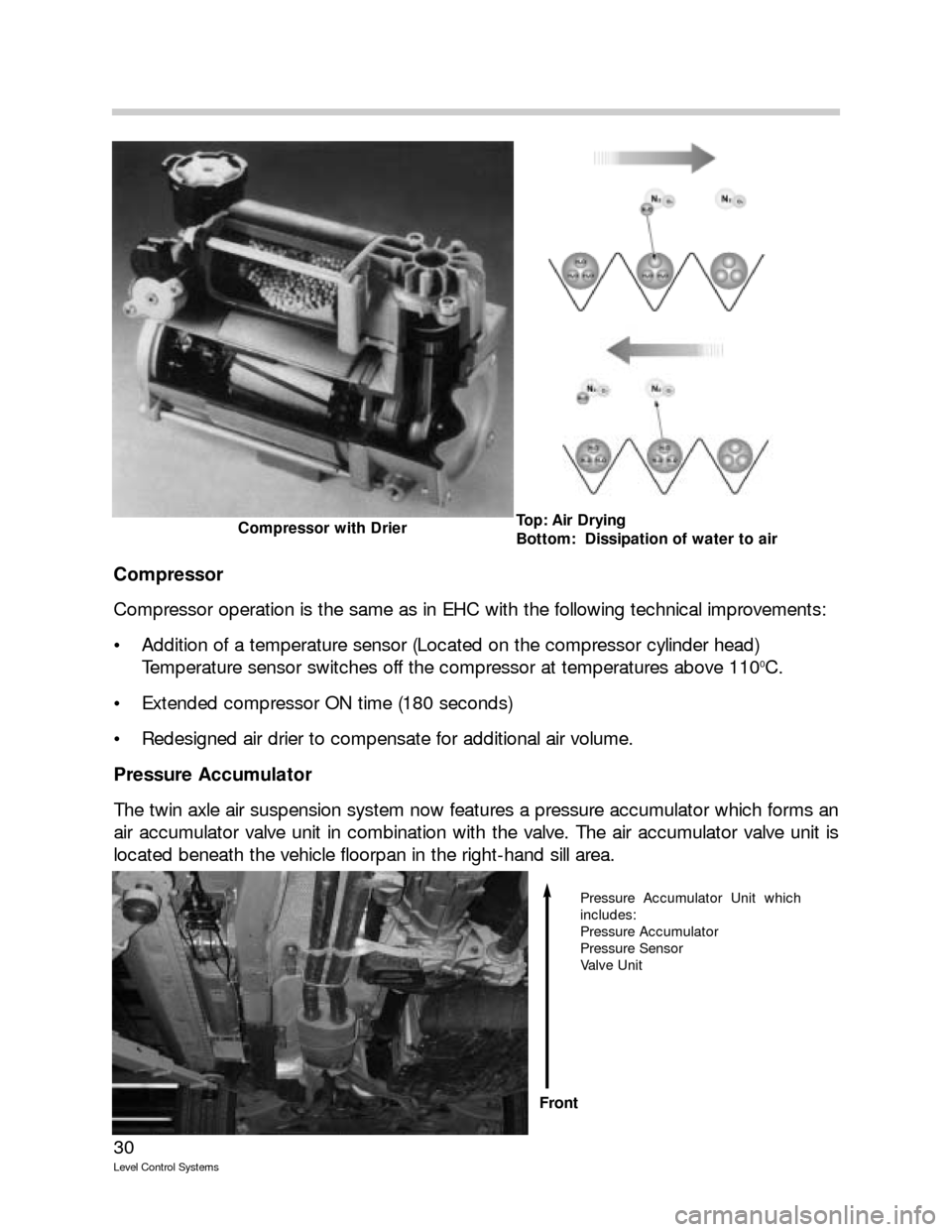
30
Level Control Systems
Compressor
Compressor operation is the same as in EHC with the following technical improvements:
Addition of a temperature sensor (Located on the compressor cylinder head)
Temperature sensor switches off the compressor at temperatures above 110
0C.
Extended compressor ON time (180 seconds)
Redesigned air drier to compensate for additional air volume.
Pressure Accumulator
The twin axle air suspension system now features a pressure accumulator which forms an
air accumulator valve unit in combination with the valve. The air accumulator valve unit is
located beneath the vehicle floorpan in the right-hand sill area.
Top: Air Drying
Bottom: Dissipation of water to airCompressor with Drier
Pressure Accumulator Unit which
includes:
Pressure Accumulator
Pressure Sensor
Valve Unit
Front
Page 31 of 57
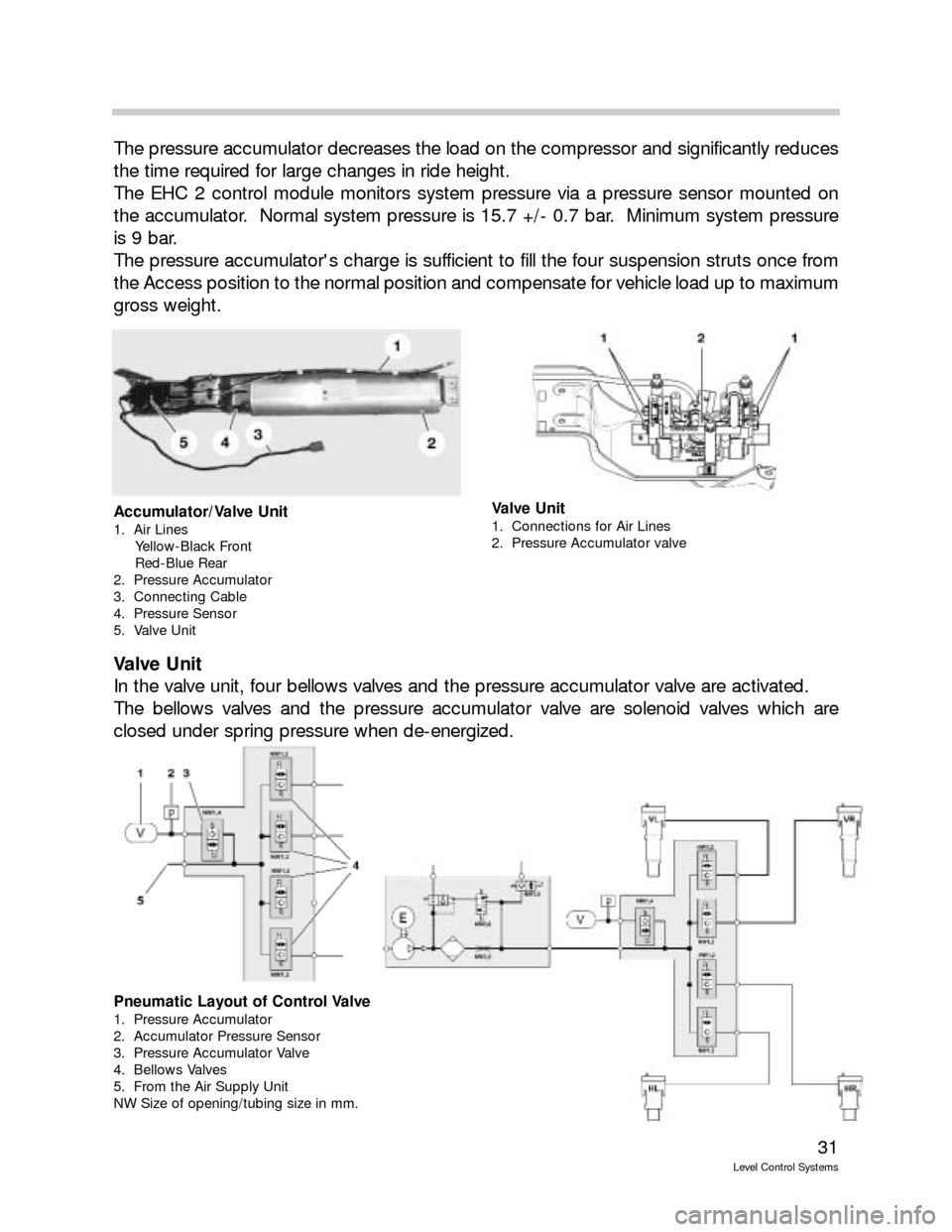
31
Level Control Systems
The pressure accumulator decreases the load on the compressor and significantly reduces
the time required for large changes in ride height.
The EHC 2 control module monitors system pressure via a pressure sensor mounted on
the accumulator. Normal system pressure is 15.7 +/- 0.7 bar. Minimum system pressure
is 9 bar.
The pressure accumulator's charge is sufficient to fill the four suspension struts once from
the Access position to the normal position and compensate for vehicle load up to maximum
gross weight.
Valve Unit
In the valve unit, four bellows valves and the pressure accumulator valve are activated.
The bellows valves and the pressure accumulator valve are solenoid valves which are
closed under spring pressure when de-energized.
Accumulator/Valve Unit
1. Air Lines
Yellow-Black Front
Red-Blue Rear
2. Pressure Accumulator
3. Connecting Cable
4. Pressure Sensor
5. Valve Unit
Valve Unit
1. Connections for Air Lines
2. Pressure Accumulator valve
Pneumatic Layout of Control Valve
1. Pressure Accumulator
2. Accumulator Pressure Sensor
3. Pressure Accumulator Valve
4. Bellows Valves
5. From the Air Supply Unit
NW Size of opening/tubing size in mm.
Page 33 of 57
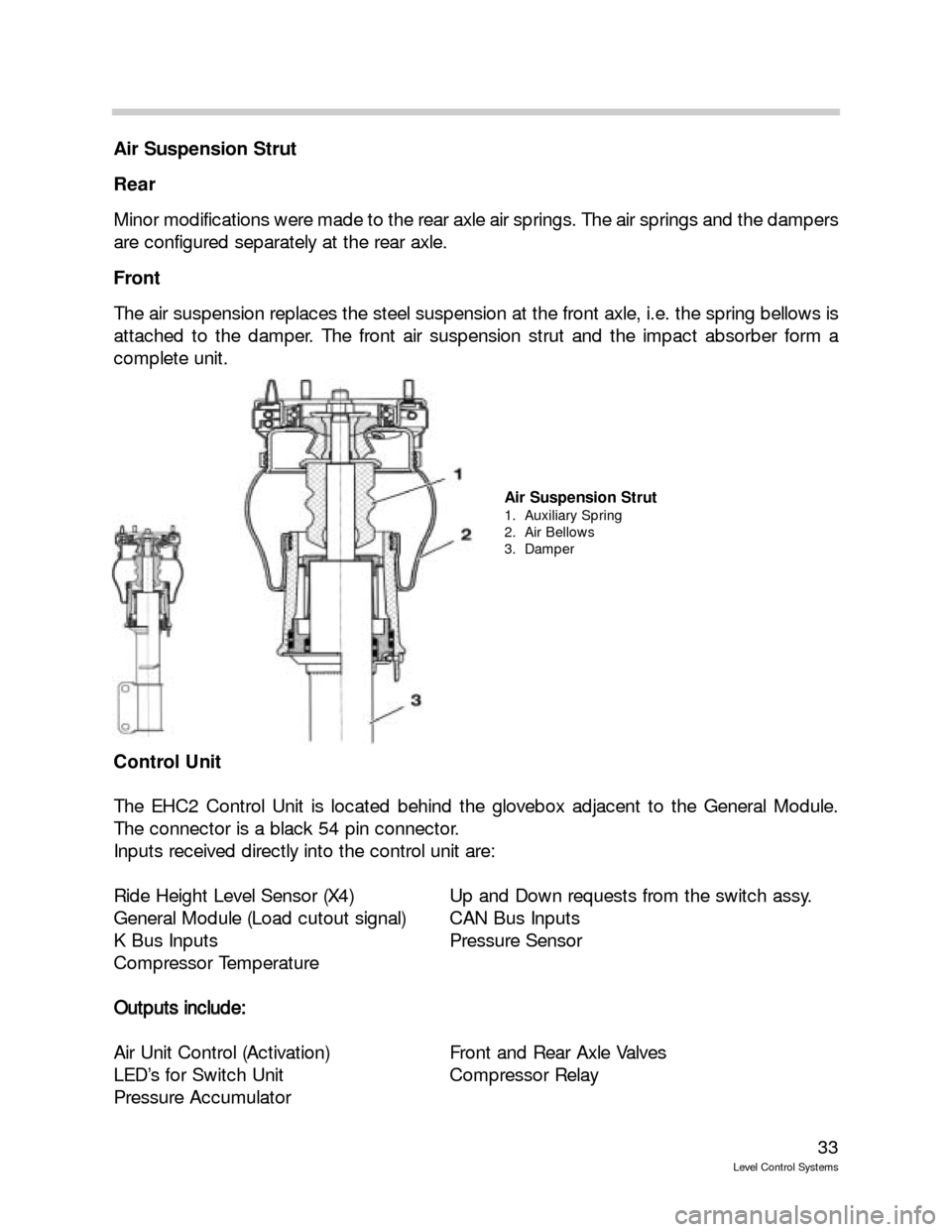
33
Level Control Systems
Air Suspension Strut
Rear
Minor modifications were made to the rear axle air springs. The air springs and the dampers
are configured separately at the rear axle.
Front
The air suspension replaces the steel suspension at the front axle, i.e. the spring bellows is
attached to the damper. The front air suspension strut and the impact absorber form a
complete unit.
Control Unit
The EHC2 Control Unit is located behind the glovebox adjacent to the General Module.
The connector is a black 54 pin connector.
Inputs received directly into the control unit are:
Ride Height Level Sensor (X4) Up and Down requests from the switch assy.
General Module (Load cutout signal) CAN Bus Inputs
K Bus Inputs Pressure Sensor
Compressor Temperature
O Ou
ut
tp
pu
ut
ts
s
i
in
nc
cl
lu
ud
de
e:
:
Air Unit Control (Activation) Front and Rear Axle Valves
LED’s for Switch Unit Compressor Relay
Pressure Accumulator
Air Suspension Strut
1. Auxiliary Spring
2. Air Bellows
3. Damper
Page 34 of 57
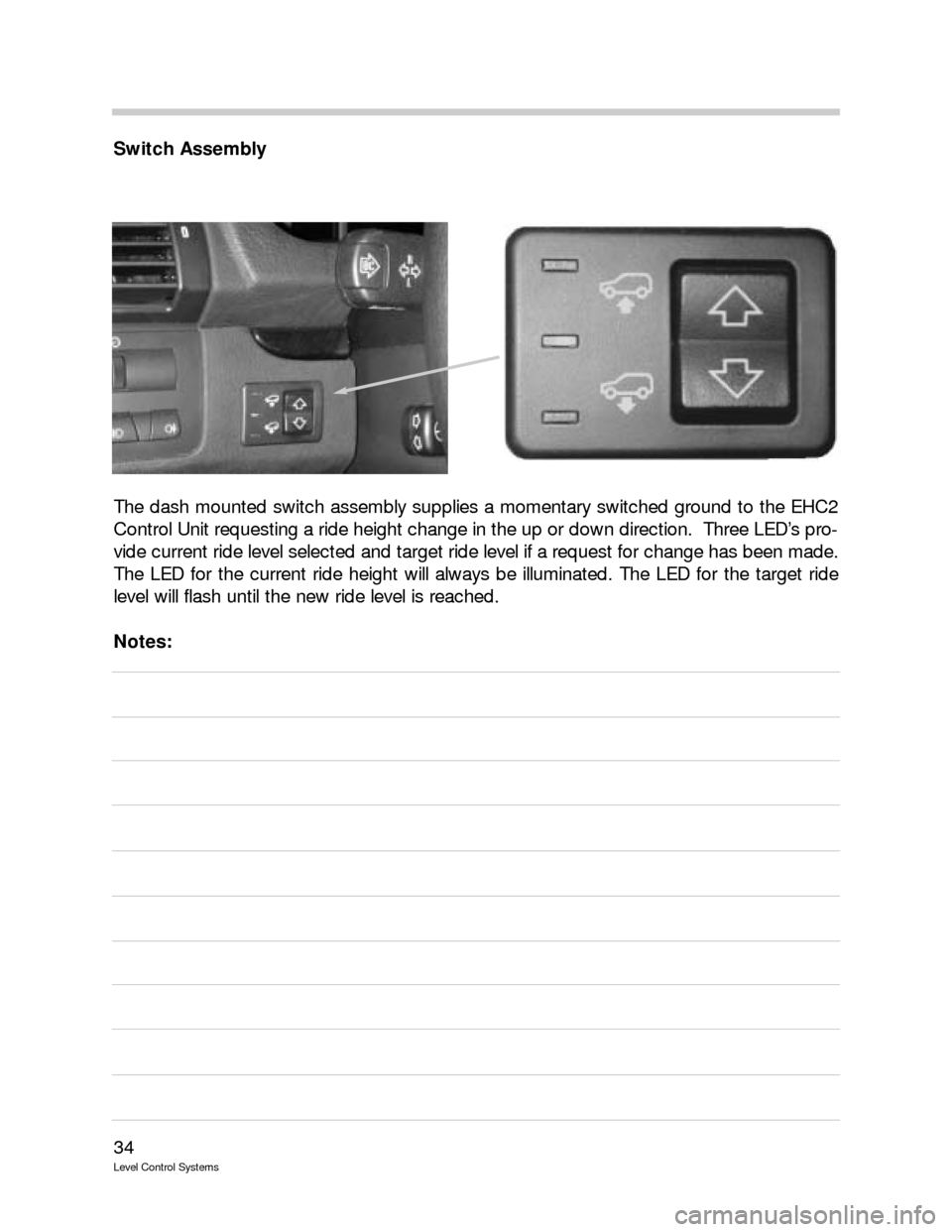
34
Level Control Systems
Switch Assembly
The dash mounted switch assembly supplies a momentary switched ground to the EHC2
Control Unit requesting a ride height change in the up or down direction. Three LED’s pro-
vide current ride level selected and target ride level if a request for change has been made.
The LED for the current ride height will always be illuminated. The LED for the target ride
level will flash until the new ride level is reached.
Notes:
Page 41 of 57
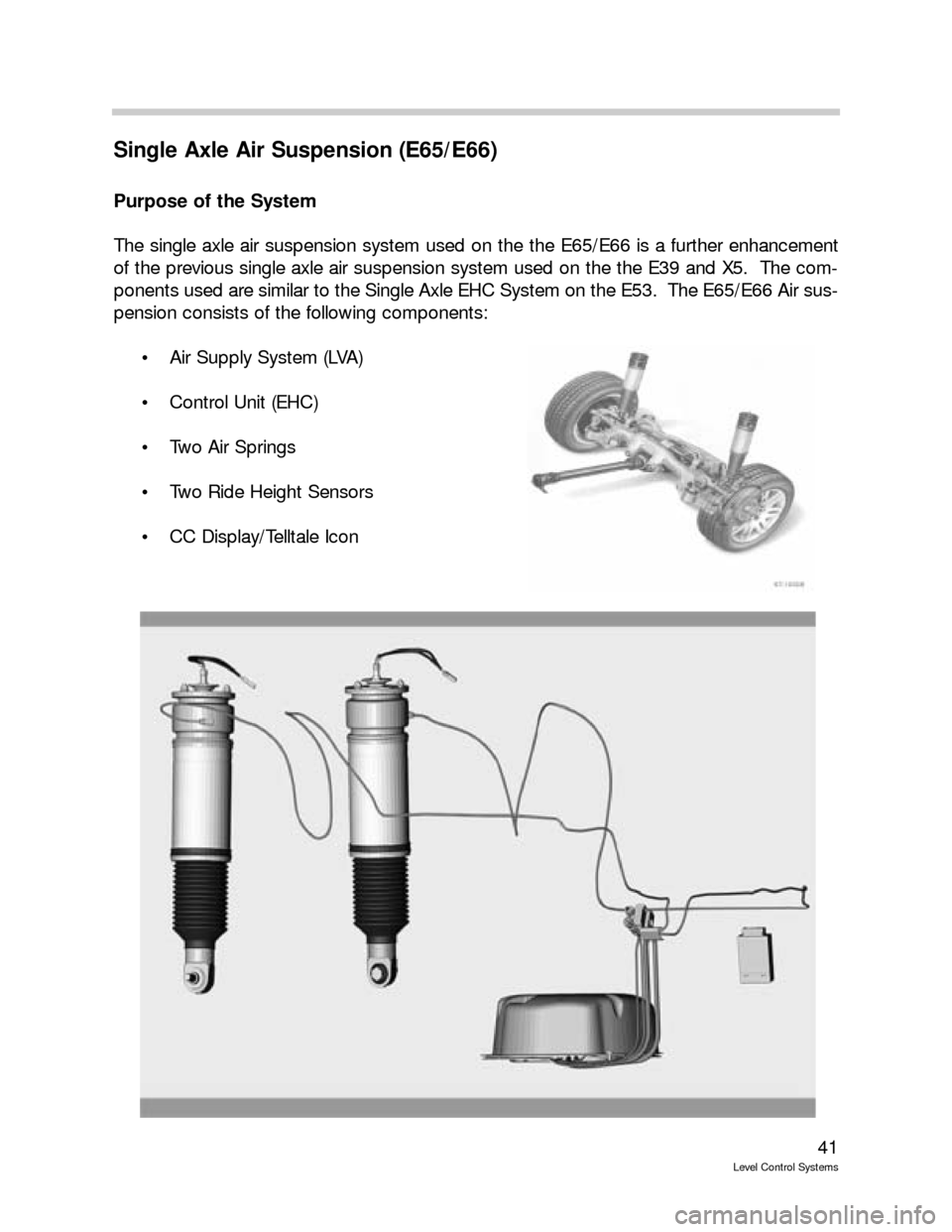
41
Level Control Systems
Single Axle Air Suspension (E65/E66)
Purpose of the System
The single axle air suspension system used on the the E65/E66 is a further enhancement
of the previous single axle air suspension system used on the the E39 and X5. The com-
ponents used are similar to the Single Axle EHC System on the E53. The E65/E66 Air sus-
pension consists of the following components:
Air Supply System (LVA)
Control Unit (EHC)
Two Air Springs
Two Ride Height Sensors
CC Display/Telltale Icon
Page 44 of 57
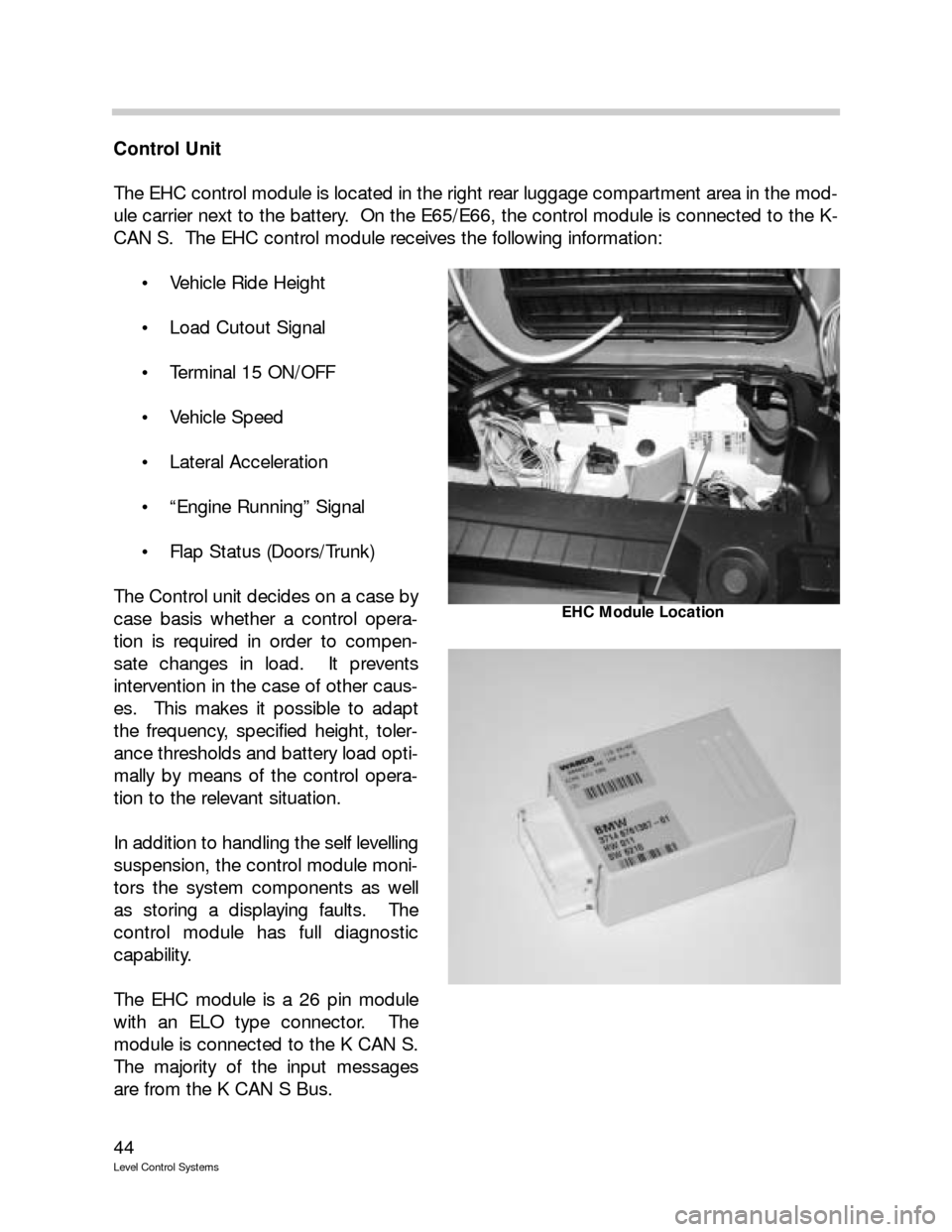
44
Level Control Systems
Control Unit
The EHC control module is located in the right rear luggage compartment area in the mod-
ule carrier next to the battery. On the E65/E66, the control module is connected to the K-
CAN S. The EHC control module receives the following information:
Vehicle Ride Height
Load Cutout Signal
Terminal 15 ON/OFF
Vehicle Speed
Lateral Acceleration
“Engine Running” Signal
Flap Status (Doors/Trunk)
The Control unit decides on a case by
case basis whether a control opera-
tion is required in order to compen-
sate changes in load. It prevents
intervention in the case of other caus-
es. This makes it possible to adapt
the frequency, specified height, toler-
ance thresholds and battery load opti-
mally by means of the control opera-
tion to the relevant situation.
In addition to handling the self levelling
suspension, the control module moni-
tors the system components as well
as storing a displaying faults. The
control module has full diagnostic
capability.
The EHC module is a 26 pin module
with an ELO type connector. The
module is connected to the K CAN S.
The majority of the input messages
are from the K CAN S Bus.
EHC Module Location
Page 46 of 57
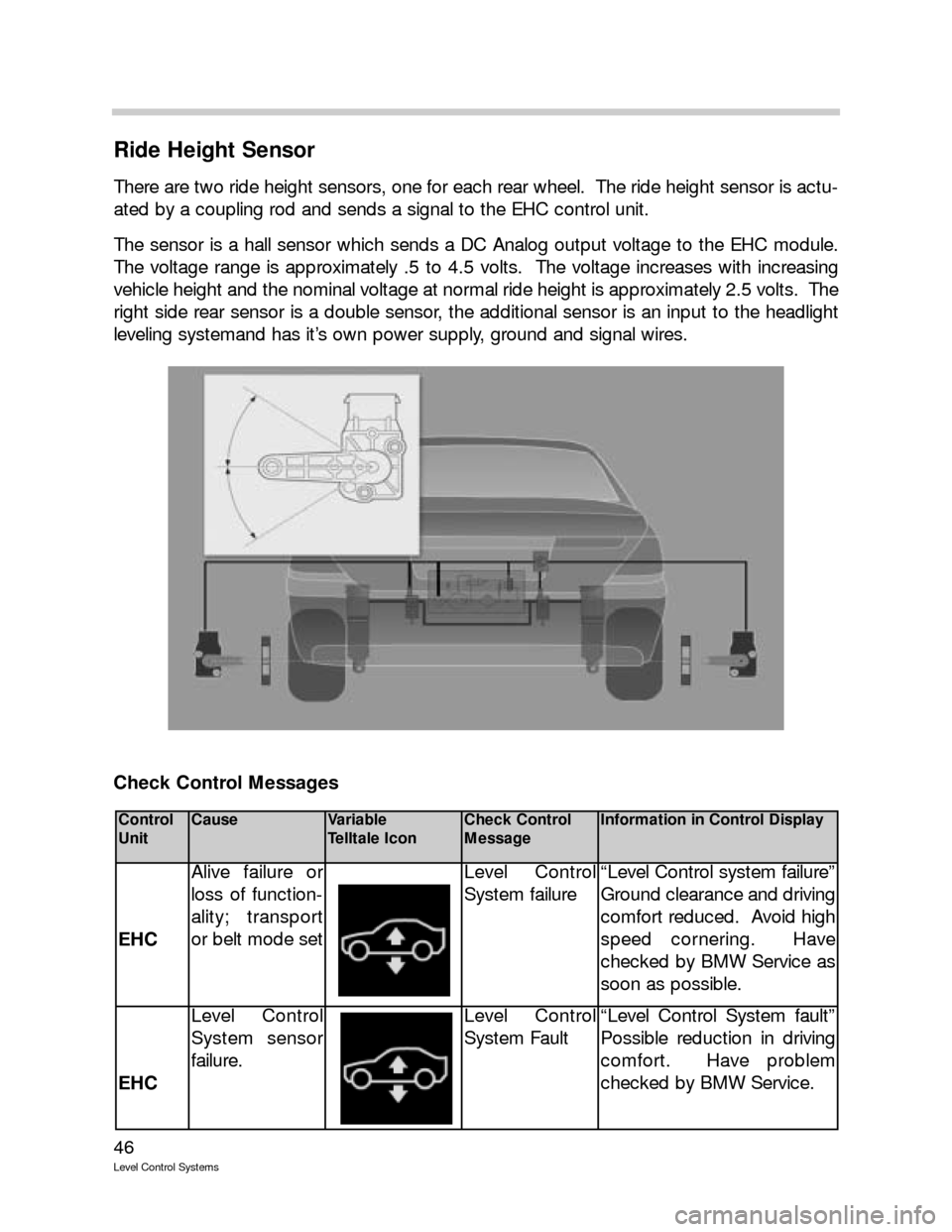
46
Level Control Systems
Ride Height Sensor
There are two ride height sensors, one for each rear wheel. The ride height sensor is actu-
ated by a coupling rod and sends a signal to the EHC control unit.
The sensor is a hall sensor which sends a DC Analog output voltage to the EHC module.
The voltage range is approximately .5 to 4.5 volts. The voltage increases with increasing
vehicle height and the nominal voltage at normal ride height is approximately 2.5 volts. The
right side rear sensor is a double sensor, the additional sensor is an input to the headlight
leveling systemand has it’s own power supply, ground and signal wires.
Check Control Messages
Control
UnitCauseVariable
Telltale IconCheck Control
MessageInformation in Control Display
EHC
Alive failure or
loss of function-
ality; transport
or belt mode setLevel Control
System failure“Level Control system failure”
Ground clearance and driving
comfort reduced. Avoid high
speed cornering. Have
checked by BMW Service as
soon as possible.
EHC
Level Control
System sensor
failure.Level Control
System Fault“Level Control System fault”
Possible reduction in driving
comfort. Have problem
checked by BMW Service.
Page 48 of 57
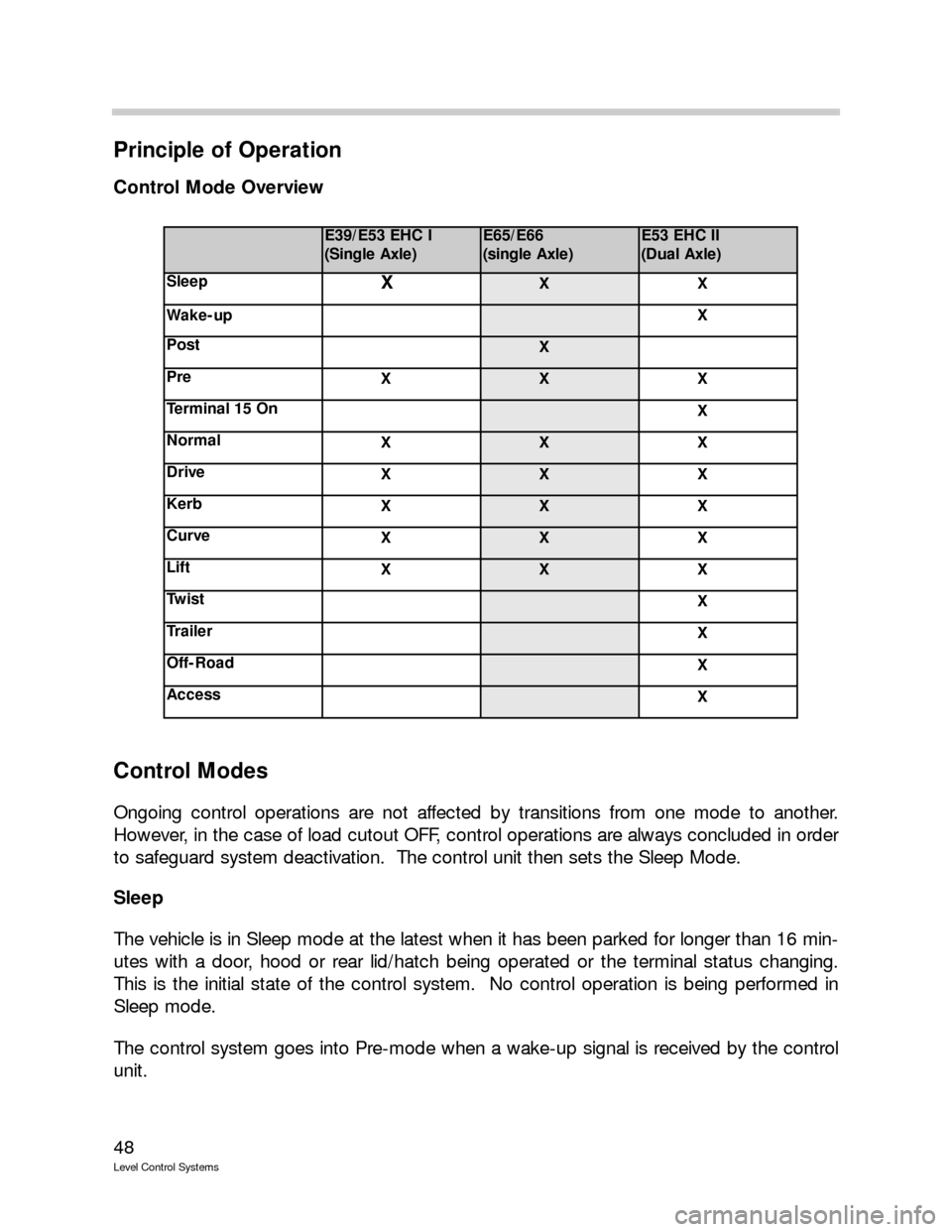
48
Level Control Systems
Principle of Operation
Control Mode Overview
Control Modes
Ongoing control operations are not affected by transitions from one mode to another.
However, in the case of load cutout OFF, control operations are always concluded in order
to safeguard system deactivation. The control unit then sets the Sleep Mode.
Sleep
The vehicle is in Sleep mode at the latest when it has been parked for longer than 16 min-
utes with a door, hood or rear lid/hatch being operated or the terminal status changing.
This is the initial state of the control system. No control operation is being performed in
Sleep mode.
The control system goes into Pre-mode when a wake-up signal is received by the control
unit.
E39/E53 EHC I
(Single Axle)E65/E66
(single Axle)E53 EHC II
(Dual Axle)
SleepXXX
Wake-upX
PostX
PreXXX
Terminal 15 OnX
NormalXXX
DriveXXX
KerbXXX
CurveXXX
LiftXXX
TwistX
TrailerX
Off-RoadX
AccessX